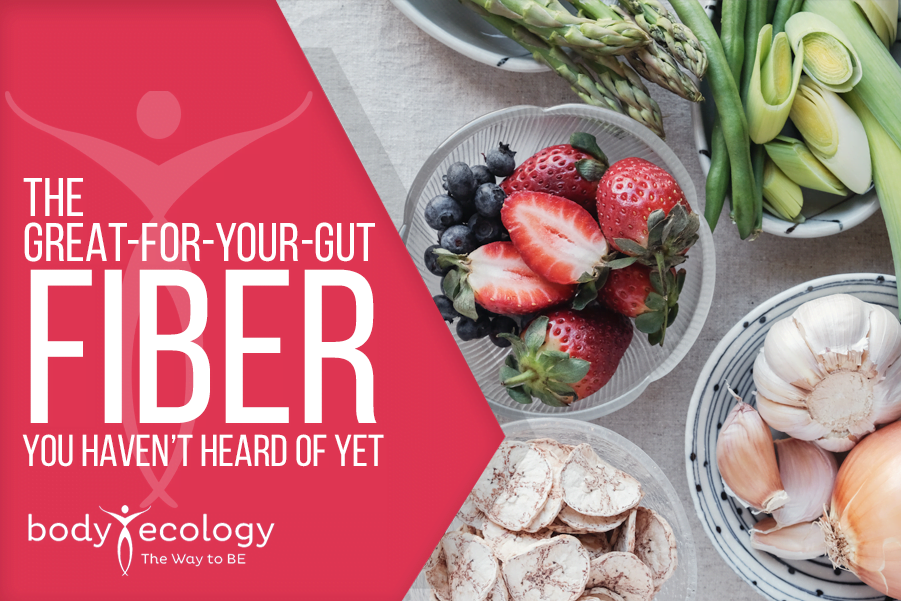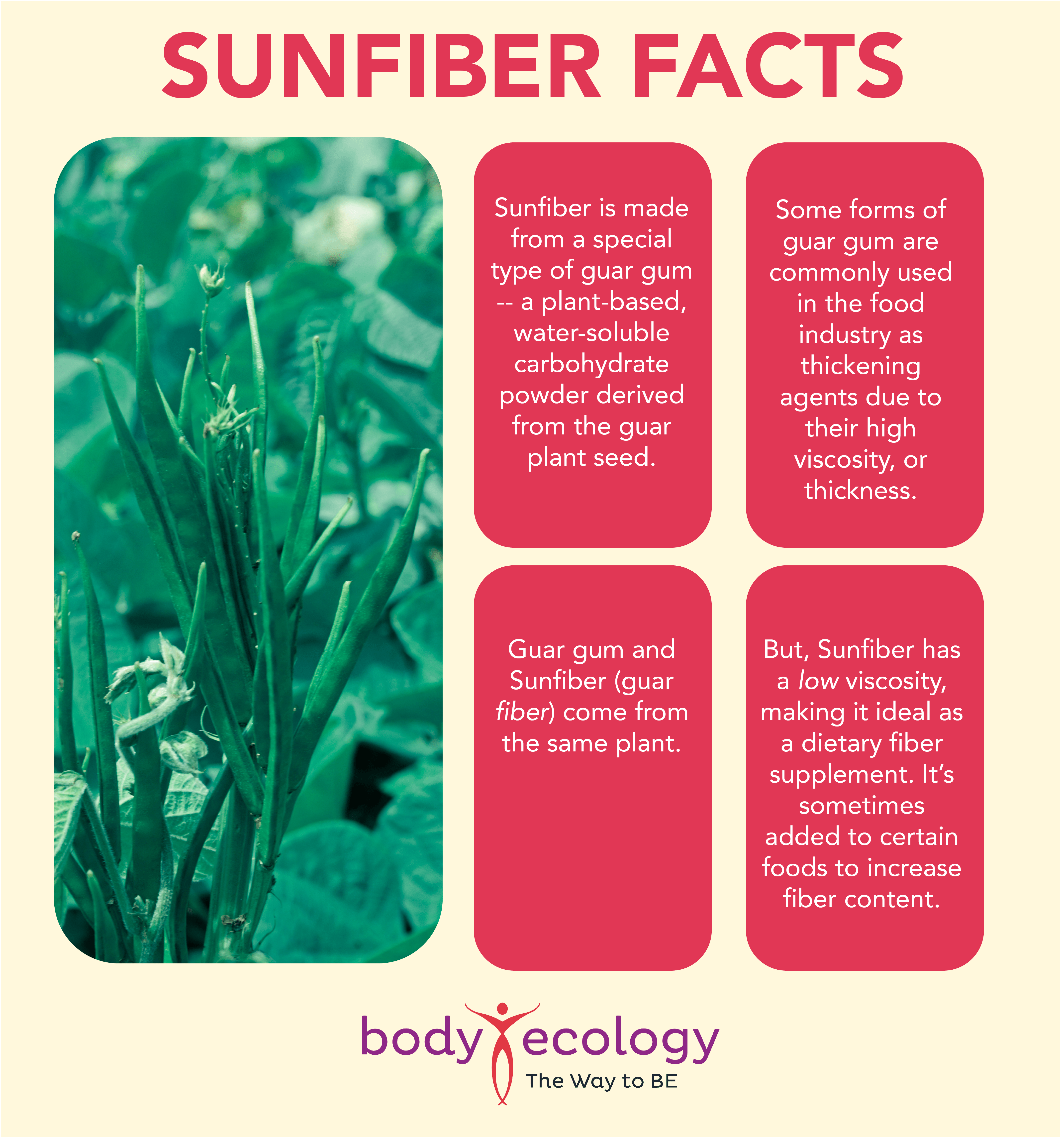
Struggling with constipation and cravings? This prebiotic delivers.
You know all about probiotics. But what about prebiotics? Prebiotics are a soluble fiber that the human body cannot digest but are broken down by the gut microbiota.
They’re a source of nourishment or, more precisely, the food source for probiotics — the beneficial bacteria that, along with other healthy microorganisms, constitute the gut microbiome in the gastrointestinal tract.
The byproducts of this process are short-chain fatty acids, which are released into the bloodstream where they provide multiple benefits for the gut and for other tissues and organs in the body.
Prebiotics can be found naturally in food, or they can be taken as a dietary supplement. Either way, they provide a host of significant health benefits.
It’s true that most Americans don’t get the recommended servings of fruits and vegetables each day, which can limit the amount of prebiotics (and fiber in general) that they consume.1
The benefits of dietary fiber are well-documented. Studies now show that for most people, 10 grams of prebiotics per day can offer notable advantages — particularly if the food sources are nutritious and plant-based and aren’t consumed through processed goods.2
While this is a useful list, be careful… Some prebiotic foods are high in oxalates. Remember, “all foods have a front and a back” — meaning, a positive and a negative side — and if you have candidiasis, you do not want to be eating foods (prebiotic or otherwise) high in oxalates. Yeast are making oxalates already — big-time.
Why are short-chain fatty acids so great for your health?
One of the more important benefits of prebiotic fiber is that it stimulates colonization, or helps populate, the colon with beneficial bacteria — bacteria that, through fermentation, manufacture compounds called short-chain fatty acids (SCFAs).
SCFAs (primarily, butyrate, acetate, propionate, and, in some cases, lactic acid) offer tremendous health benefits for the gut, immune system, nervous system, cardiovascular system, and even the skin.3
Broadly speaking, this important process of fermentation in the gut provides many benefits for the human body.4 This is because gut microbiota regulate all gastrointestinal activity, including metabolism and the overall health of the gut.
For example, beneficial organisms in the gut help shape your immunity, and these microscopic alchemists can overpower many pathogenic bacteria strains in most people with healthy immune systems. Beneficial strains, like Bifidobacterium and Lactobacillus, are produced by lactic acid — which, along with other protective immune-boosting compounds, can help keep harmful bacteria from proliferating.
To make sure you’re getting plenty of these strains of beneficial bacteria, consider taking Body Ecology’s brand-new GI Distress Relief™, a powerhouse probiotic featuring 40 billion Bifidus lactis, as well as Sunfiber and S. boulardii, per serving.
Our probiotic liquids, like CocoBiotic, are a must because they provide diversity — lots of diversity — and that’s critical to help create a robust microbiome. We recommend drinking at least 3 ounces per day to supply a significant amount of Lactobacillus bacteria.
To summarize, why are short-chain fatty acids so important?
- They reduce inflammation. SCFAs control the release of inflammatory compounds in the body.5 They help white blood cells reach the target site of inflammation to destroy microbial pathogens.
- SCFAs have the ability to defuse harmful bacteria in the gut. This helps protect the body against pathogenic infections. By monitoring the action of immune cells, SCFAs can neutralize pathogenic bacteria without having to activate the immune system (though it’s unclear how SCFAs communicate with immune cells for this purpose).6
- SCFAs help create the mucosal barrier that lines the gut.7 Meaning, they play an important role in digestive health. The lubrication provided by the lining of the gut helps food pass through the GI tract easily. It also forms a protective layer over the stomach, which prevents the stomach, existing within an acidic environment, from digesting itself.
The rate of SCFA production in the body is important, but keep in mind that it’s best to increase soluble fiber gradually. If the fermentation process occurs too rapidly, the short-term result can be uncomfortable gas and bloating.
Want to know exactly how to eat for your optimal gut health and wellness? Grab your free Getting Started Guide now.
Introducing Sunfiber: What makes this prebiotic so different?
A slower fermentation of fiber in the gut is preferred and is one of the reasons why at Body Ecology, we’re pleased to make a Sunfiber prebiotic dietary supplement fiber available to our readers. Sunfiber’s rate of fermentation is slower, so it allows a higher total amount of SCFAs to be produced over time, resulting in less gas, bloating, and overall GI discomfort.8
Other soluble prebiotic fibers like inulin, while generally safe and effective, can produce excessive amounts of gas and bloating when consumed in large quantities. These symptoms (considered side effects) may worsen at higher doses (more than 10 grams).9

Sunfiber’s lower viscosity is a result of a process applied to the guar gum called hydrolysis. The process of hydrolysis is what makes this prebiotic dietary supplement partially hydrolyzed guar gum (PHGG).
What’s meant by “hydrolyzed?”
- A hydrolyzed substance is one that has gone through the process of hydrolysis whereby, in this case, guar gum gets broken down into smaller pieces.
- This happens as part of a meticulous process that allows natural enzymes to break apart fragments of guar gum that decrease the guar gum’s viscosity.
- The process enables guar gum to dissolve easily in water or other liquids, while maintaining its original fiber content.
Research on the Sunfiber prebiotic shows it promotes bowel regularity and also helps create feelings of satiety or fullness.10 And so, it may help regulate blood sugar by slowing down the absorption of sugars in the body when PHGG is consumed with a meal or snack.11
PHGG has also been shown to increase nutrient absorption and support healthy digestive function in general.12,13 Part of Sunfiber’s appeal is that it’s colorless, odorless, and tasteless; has no texture; and completely dissolves in water, a drink, baked goods, and especially your favorite protein shake.
Sunfiber is a soluble dietary fiber that’s easily added to a wide variety of foods, beverages, and supplements. It’s a gut health superstar. Because it doesn’t change the flavor of the product to which it’s added, Sunfiber offers a handy way to increase fiber in your diet — almost without even knowing you’re consuming it.
REFERENCES:
- 1. Lee-Kwan SH, Moore LV, Blanck HM, Harris DM, Galuska D. Disparities in State-Specific Adult Fruit and Vegetable Consumption — United States, 2015. MMWR Morb Mortal Wkly Rep 2017;66:1241–1247. DOI: http://dx.doi.org/10.15585/mmwr.mm6645a1external icon.
- 2. Slavin, Joanne. (2013). Fiber and Prebiotics: Mechanisms and Health Benefits. Nutrients. 5. 1417-35. 10.3390/nu5041417.
- 3. Davani-Davari D, Negahdaripour M, Karimzadeh I, et al. Prebiotics: Definition, Types, Sources, Mechanisms, and Clinical Applications. Foods. 2019;8(3):92. Published 2019 Mar 9. doi:10.3390/foods8030092.
- 4. Slavin J. Fiber and prebiotics: mechanisms and health benefits. Nutrients. 2013 Apr 22;5(4):1417-35. doi: 10.3390/nu5041417. PMID: 23609775; PMCID: PMC3705355.
- 5. Vinolo MA, Rodrigues HG, Nachbar RT, Curi R. Regulation of inflammation by short chain fatty acids. Nutrients. 2011;3(10):858-876. doi:10.3390/nu3100858.
- 6. van Limpt, C., Crienen, A., Vriesema, A. et al. 134 Effect of Colonic Short Chain Fatty Acids, Lactate and PH on The Growth of Common Gut Pathogens. Pediatr Res 56, 487 (2004). https://doi.org/10.1203/00006450-200409000-00157.
- 7. Sara Deleu, Kathleen Machiels, Jeroen Raes, Kristin Verbeke, Séverine Vermeire, Short chain fatty acids and its producing organisms: An overlooked therapy for IBD?, EBioMedicine, Volume 66, 2021, 103293, ISSN 2352-3964, https://doi.org/10.1016/j.ebiom.2021.103293.
- 8. Cummings JH, Branch W, Jenkins DJ, Southgate DA, Houston H, James WP. Colonic response to dietary fibre from carrot, cabbage, apple, bran. Lancet. 1978 Jan 7;1(8054):5-9. doi: 10.1016/s0140-6736(78)90357-4. PMID: 74533.
- 9. Bonnema AL, Kolberg LW, Thomas W, Slavin JL. Gastrointestinal tolerance of chicory inulin products. J Am Diet Assoc. 2010 Jun;110(6):865-8. doi: 10.1016/j.jada.2010.03.025. PMID: 20497775.
- 10. Mahendra P. Kapoor, Masaaki Sugita, Yoshitaka Fukuzawa, Tsutomu Okubo, Impact of partially hydrolyzed guar gum (PHGG) on constipation prevention: A systematic review and meta-analysis, Journal of Functional Foods, Volume 33, 2017, Pages 52-66, ISSN 1756-4646, https://doi.org/10.1016/j.jff.2017.03.028.
- 11. Rao TP, Hayakawa M, Minami T, Ishihara N, Kapoor MP, Ohkubo T, Juneja LR, Wakabayashi K. Post-meal perceivable satiety and subsequent energy intake with intake of partially hydrolysed guar gum. Br J Nutr. 2015 May 14;113(9):1489-98. doi: 10.1017/S0007114515000756. Epub 2015 Apr 8. PMID: 25851425.
- 12. de Cássia Freitas K, Amancio OM, Ferreira Novo N, Fagundes-Neto U, de Morais MB. Partially hydrolyzed guar gum increases intestinal absorption of iron in growing rats with iron deficiency anemia. Clin Nutr. 2006 Oct;25(5):851-8. doi: 10.1016/j.clnu.2006.02.010. Epub 2006 May 5. PMID: 16678310.
- 13. vTakahashi H, Wako N, Okubo T, Ishihara N, Yamanaka J, Yamamoto T. Influence of partially hydrolyzed guar gum on constipation in women. J Nutr Sci Vitaminol (Tokyo). 1994 Jun;40(3):251-9. doi: 10.3177/jnsv.40.251. PMID: 7965214.










